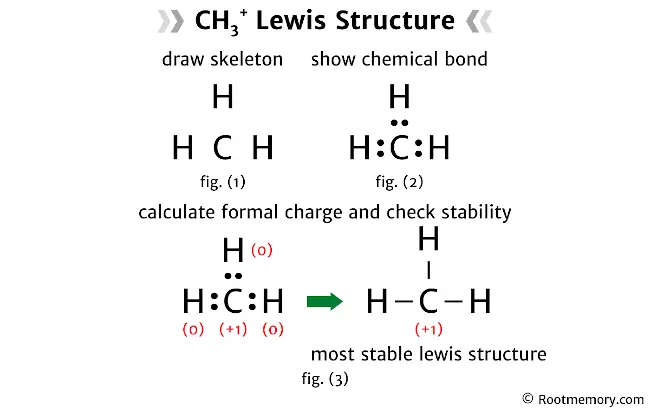
The CH3+ Lewis structure illustrates the molecular arrangement of methenium, with a central carbon atom at its core. This carbon atom forms single bonds with three hydrogen atoms, with no lone pairs observed on either the carbon or hydrogen atoms. It is worth noting that a positive charge of +1 is present on the carbon atom.
For an accurate representation of the CH3+ Lewis structure, begin by creating a rough diagram. Show chemical bonds between each atom and identify any lone pairs. Proceed to ensure the octet rule is satisfied for both the central carbon atom and the surrounding hydrogen atoms. Lastly, verify the structure’s stability by calculating formal charges for each atom. Aim for a stable Lewis structure with minimal formal charges.
Alternative method: Lewis structure of CH3+
Steps
Rough sketch
In this step, first calculate the total number of valence electrons. And then, decide the central atom.
- Let’s calculate the total number of valence electrons
We know that… carbon is a group 14 element and hydrogen is a group 1 element. Hence, carbon has four valence electrons and hydrogen has one valence electron.
Now CH3+ has one carbon atom and three hydrogen atoms.
So the total number of valence electrons = valence electrons of carbon atom + (valence electrons of hydrogen atom × 3)
And CH3+ has a positive (+1) charge, so we have to subtract one electron.
Therefore, the total number of valence electrons = 4 + 3 – 1 = 6
- Now decide the central atom
We can not assume hydrogen as the central atom, because the central atom is bonded with at least two other atoms. And hydrogen has only one electron in its last shell, so it can not make more than one bond.
Hence, assume that carbon is the central atom.
So now, put carbon in the center and hydrogens on either side. And draw the rough skeleton structure for the CH3+ Lewis structure something like this:

Also read: How to draw Lewis structure of CH3NCO (5 steps)
Chemical bond
Place two electrons between the atoms to show a chemical bond. Since carbon is surrounded by three hydrogens, use six electrons to show three chemical bonds as follows:

In the above structure, you can see that the octet is completed on outside atoms. But, the central atom (carbon) doesn’t form an octet.
Now carbon has an exception in CH3+, that it does not require eight electrons to complete its octet.
So one last thing we need to do is, calculate the formal charge and check the stability of the above structure.
Also read: How to draw Lewis structure of CO2 (5 steps)
Formal charge and stability
The following formula is used to calculate the formal charges on atoms:
Formal charge = valence electrons – nonbonding electrons – ½ bonding electrons
Collect the data from the above structure and then, write it down below as follows:
- For carbon atom
Valence electrons = 4
Nonbonding electrons = 0
Bonding electrons = 6
Formal charge = 4 – 0 – ½ (6) = +1
- For each hydrogen atom
Valence electrons = 1
Nonbonding electrons = 0
Bonding electrons = 2
Formal charge = 1 – 0 – ½ (2) = 0
Mention the formal charges of atoms on the structure. So the CH3+ Lewis structure looks something like this:

In the above structure, you can see that the formal charges of atoms are closer to zero. Therefore, this is the most stable Lewis structure of CH3+.
And each horizontal line drawn in the above structure represents a pair of bonding valence electrons.
Now CH3+ is an ion having a positive (+1) charge, so draw brackets around the above Lewis structure and mention that charge on the top right corner. And then, the CH3+ Lewis structure looks something like this:

Next: Lewis structure of CH3NCO
Related
- Lewis structure of CH3NCO
- Lewis structure of CO2
- Lewis structure of H2O
- Lewis structure of NO2
- Lewis structure of NH3
External video
- CH3+ Lewis Structure: How to Draw the Lewis Structure for CH3+ – YouTube • Wayne Breslyn
External links
- CH3+ lewis structure, molecular geometry, bond angle, hybridization – Topblogtenz
- Draw the Lewis Structure for CH3+ – Chegg
- Methylium | CH3+ | CID 644094 – National Institutes of Health (.gov)
- What is the best Lewis structure for CH3+1? What is the formal charge on the C? – Quora
- Draw the Lewis Structure for CH3+ – Bartleby
Deep
Rootmemory.com was founded by Deep Rana, who is a mechanical engineer by profession and a blogger by passion. He has a good conceptual knowledge on different educational topics and he provides the same on this website. He loves to learn something new everyday and believes that the best utilization of free time is developing a new skill.
